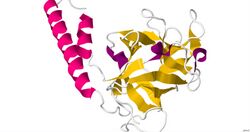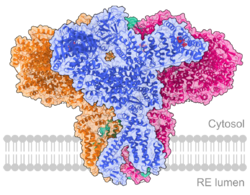Biology:Inositol trisphosphate receptor
| inositol 1,4,5-trisphosphate receptor, type 1[1] | |
|---|---|
 Crystal structure of the ligand binding suppressor domain of type 1 inositol 1,4,5-trisphosphate receptor | |
| Identifiers | |
| Symbol | ITPR1 |
| NCBI gene | 3708 |
| HGNC | 6180 |
| OMIM | 147265 |
| RefSeq | NM_002222 |
| UniProt | Q14643 |
| Other data | |
| Locus | Chr. 3 p26.1 |
| inositol 1,4,5-trisphosphate receptor, type 3 | |
|---|---|
 Single-particle cryo-EM structure of the IP3-bound resting state. | |
| Identifiers | |
| Symbol | ITPR3 |
| NCBI gene | 3710 |
| HGNC | 6182 |
| OMIM | 147267 |
| RefSeq | NM_002224 |
| UniProt | Q14573 |
| Other data | |
| Locus | Chr. 6 p21.31 |
Inositol trisphosphate receptor (InsP3R) is a membrane glycoprotein complex acting as a Ca2+ channel activated by inositol trisphosphate (InsP3). InsP3R is very diverse among organisms, and is necessary for the control of cellular and physiological processes including cell division, cell proliferation, apoptosis, fertilization, development, behavior, learning and memory.[2] Inositol triphosphate receptor represents a dominant second messenger leading to the release of Ca2+ from intracellular store sites. There is strong evidence suggesting that the InsP3R plays an important role in the conversion of external stimuli to intracellular Ca2+ signals characterized by complex patterns relative to both space and time, such as Ca2+ waves and oscillations.[3]
Discovery
The InsP3 receptor was first purified from rat cerebellum by neuroscientists Surachai Supattapone and Solomon Snyder at Johns Hopkins University School of Medicine.[4]
The cDNA of the InsP3 receptor was first cloned in the laboratory of Katsuhiko Mikoshiba. The initial sequencing was reported as an unknown protein enriched in the cerebellum called P400.[5] The large size of this open reading frame indicated a molecular weight similar to the protein purified biochemically, and soon thereafter it was confirmed that the protein p400 was in fact the inositol trisphosphate receptor.[6]
Distribution
The receptor has a broad tissue distribution but is especially abundant in the cerebellum. Most of the InsP3Rs are found integrated into the endoplasmic reticulum.
Structure
Several X-ray crystallographic [7][8][9] and electron cryomicroscopic (cryo-EM) [10][11][12][13][14][15][16] structures of IP3Rs from mouse, rat, and human have defined the overall architecture of the channel. The 1.2 MDa C4-symmetric assembly consists of an ER-embedded transmembrane domain (TMD) in a domain-swapped 6 transmembrane (6TM) cation channel fold that is capped by a large cytosolic domain (CD). In this manner, IP3Rs share significant homology with the much larger and distantly-related RyRs.[17] The CD contains all known ligand binding sites, including the IP3 binding site, two Ca2+ binding sites, an adenine nucleotide binding site, and a C2H2 Zn2+ finger fold. A comprehensive Ca2+-dependent conformational landscape has recently been defined by cryo-EM.[18]
See also
- Inositol
- Inositol phosphate
- Inositol monophosphate
- Inositol trisphosphate
- Inositol pentakisphosphate
- Inositol hexaphosphate
- MRVI1 associated through complex formation.
References
- ↑ "Crystal structure of the ligand binding suppressor domain of type 1 inositol 1,4,5-trisphosphate receptor". Molecular Cell 17 (2): 193–203. January 2005. doi:10.1016/j.molcel.2004.11.047. PMID 15664189.
- ↑ "Structure of the inositol 1,4,5-trisphosphate receptor binding core in complex with its ligand". Nature 420 (6916): 696–700. December 2002. doi:10.1038/nature01268. PMID 12442173. Bibcode: 2002Natur.420..696B.
- ↑ "Structure and function of inositol 1,4,5-trisphosphate receptor". Japanese Journal of Pharmacology 74 (2): 125–137. June 1997. doi:10.1254/jjp.74.125. PMID 9243320.
- ↑ "Solubilization, purification, and characterization of an inositol trisphosphate receptor". The Journal of Biological Chemistry 263 (3): 1530–1534. January 1988. doi:10.1016/S0021-9258(19)57336-7. PMID 2826483.
- ↑ "Nucleotide sequence of cDNA encoding P400 protein in the mouse cerebellum". Nucleic Acids Research 17 (13): 5385–5386. July 1989. doi:10.1093/nar/17.13.5385. PMID 2762133.
- ↑ "Primary structure and functional expression of the inositol 1,4,5-trisphosphate-binding protein P400". Nature 342 (6245): 32–38. November 1989. doi:10.1038/342032a0. PMID 2554142. Bibcode: 1989Natur.342...32F.
- ↑ "Structure of the inositol 1,4,5-trisphosphate receptor binding core in complex with its ligand". Nature 420 (6916): 696–700. December 2002. doi:10.1038/nature01268. PMID 12442173. Bibcode: 2002Natur.420..696B.
- ↑ "Apo and InsP₃-bound crystal structures of the ligand-binding domain of an InsP₃ receptor". Nature Structural & Molecular Biology 18 (10): 1172–1174. September 2011. doi:10.1038/nsmb.2112. PMID 21892169.
- ↑ "Structural and functional conservation of key domains in InsP3 and ryanodine receptors". Nature 483 (7387): 108–112. January 2012. doi:10.1038/nature10751. PMID 22286060. Bibcode: 2012Natur.483..108S.
- ↑ "Gating machinery of InsP3R channels revealed by electron cryomicroscopy". Nature 527 (7578): 336–341. November 2015. doi:10.1038/nature15249. PMID 26458101. Bibcode: 2015Natur.527..336F.
- ↑ "Structural basis for the regulation of inositol trisphosphate receptors by Ca2+ and IP3". Nature Structural & Molecular Biology 25 (8): 660–668. August 2018. doi:10.1038/s41594-018-0089-6. PMID 30013099.
- ↑ "Cryo-EM reveals ligand induced allostery underlying InsP3R channel gating". Cell Research 28 (12): 1158–1170. December 2018. doi:10.1038/s41422-018-0108-5. PMID 30470765.
- ↑ "Cryo-EM structure of human type-3 inositol triphosphate receptor reveals the presence of a self-binding peptide that acts as an antagonist". The Journal of Biological Chemistry 295 (6): 1743–1753. February 2020. doi:10.1074/jbc.RA119.011570. PMID 31915246.
- ↑ "Cryo-EM structure of type 1 IP3R channel in a lipid bilayer". Communications Biology 4 (1): 625. May 2021. doi:10.1038/s42003-021-02156-4. PMID 34035440.
- ↑ "Structural basis for activation and gating of IP3 receptors". Nature Communications 13 (1): 1408. March 2022. doi:10.1038/s41467-022-29073-2. PMID 35301323. Bibcode: 2022NatCo..13.1408S.
- ↑ "Conformational motions and ligand-binding underlying gating and regulation in IP3R channel". Nature Communications 13 (1): 6942. November 2022. doi:10.1038/s41467-022-34574-1. PMID 36376291. Bibcode: 2022NatCo..13.6942F.
- ↑ "Calcium-release channels: structure and function of IP3 receptors and ryanodine receptors". Physiological Reviews 102 (1): 209–268. January 2022. doi:10.1152/physrev.00033.2020. PMID 34280054.
- ↑ Paknejad, Navid; Sapuru, Vinay; Hite, Richard K. (2023-10-28). "Structural titration reveals Ca2+-dependent conformational landscape of the IP3 receptor" (in en). Nature Communications 14 (1): 6897. doi:10.1038/s41467-023-42707-3. ISSN 2041-1723. PMID 37898605.
External links
- Inositol+Trisphosphate+Receptor at the US National Library of Medicine Medical Subject Headings (MeSH)
 |

